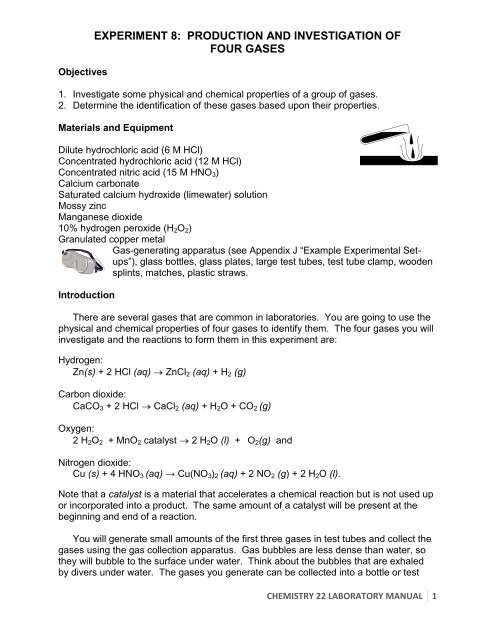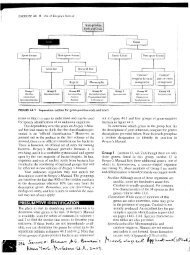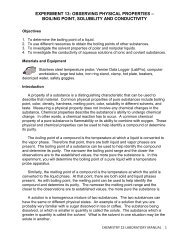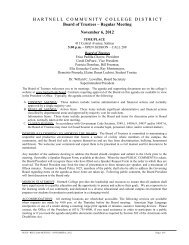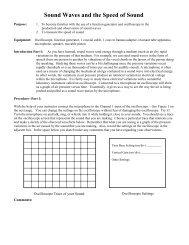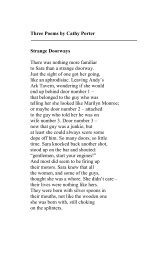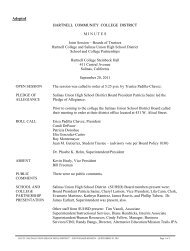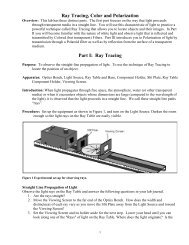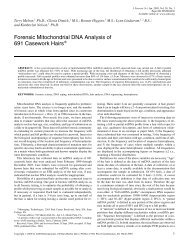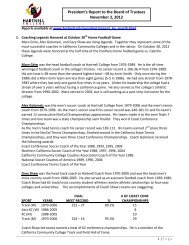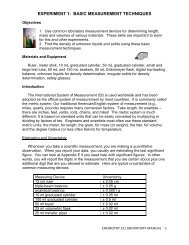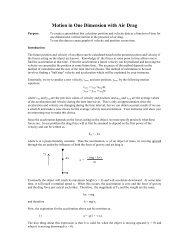experiment 8: production and investigation of four gases
experiment 8: production and investigation of four gases
experiment 8: production and investigation of four gases
Create successful ePaper yourself
Turn your PDF publications into a flip-book with our unique Google optimized e-Paper software.
Objectives<br />
EXPERIMENT 8: PRODUCTION AND INVESTIGATION OF<br />
FOUR GASES<br />
1. Investigate some physical <strong>and</strong> chemical properties <strong>of</strong> a group <strong>of</strong> <strong>gases</strong>.<br />
2. Determine the identification <strong>of</strong> these <strong>gases</strong> based upon their properties.<br />
Materials <strong>and</strong> Equipment<br />
Dilute hydrochloric acid (6 M HCl)<br />
Concentrated hydrochloric acid (12 M HCl)<br />
Concentrated nitric acid (15 M HNO 3 )<br />
Calcium carbonate<br />
Saturated calcium hydroxide (limewater) solution<br />
Mossy zinc<br />
Manganese dioxide<br />
10% hydrogen peroxide (H 2 O 2 )<br />
Granulated copper metal<br />
Gas-generating apparatus (see Appendix J “Example Experimental Setups”),<br />
glass bottles, glass plates, large test tubes, test tube clamp, wooden<br />
splints, matches, plastic straws.<br />
Introduction<br />
There are several <strong>gases</strong> that are common in laboratories. You are going to use the<br />
physical <strong>and</strong> chemical properties <strong>of</strong> <strong>four</strong> <strong>gases</strong> to identify them. The <strong>four</strong> <strong>gases</strong> you will<br />
investigate <strong>and</strong> the reactions to form them in this <strong>experiment</strong> are:<br />
Hydrogen:<br />
Zn(s) + 2 HCl (aq)<br />
Carbon dioxide:<br />
CaCO 3 + 2 HCl<br />
ZnCl 2 (aq) + H 2 (g)<br />
CaCl 2 (aq) + H 2 O + CO 2 (g)<br />
Oxygen:<br />
2 H 2 O 2 + MnO 2 catalyst 2 H 2 O (l) + O 2 (g) <strong>and</strong><br />
Nitrogen dioxide:<br />
Cu (s) + 4 HNO 3 (aq) → Cu(NO 3 ) 2 (aq) + 2 NO 2 (g) + 2 H 2 O (l).<br />
Note that a catalyst is a material that accelerates a chemical reaction but is not used up<br />
or incorporated into a product. The same amount <strong>of</strong> a catalyst will be present at the<br />
beginning <strong>and</strong> end <strong>of</strong> a reaction.<br />
You will generate small amounts <strong>of</strong> the first three <strong>gases</strong> in test tubes <strong>and</strong> collect the<br />
<strong>gases</strong> using the gas collection apparatus. Gas bubbles are less dense than water, so<br />
they will bubble to the surface under water. Think about the bubbles that are exhaled<br />
by divers under water. The <strong>gases</strong> you generate can be collected into a bottle or test<br />
CHEMISTRY 22 LABORATORY MANUAL 1
tube for further <strong>investigation</strong>. Your instructor will produce nitrogen dioxide as a<br />
demonstration.<br />
Procedure<br />
Part 1.<br />
Hydrogen<br />
1. Assemble the gas-generating apparatus as shown in Appendix J “Example<br />
Experimental Set-ups”. Remove the stopper with the gas delivery tube for later use.<br />
Fill the pneumatic trough with tap water.<br />
2. Fill a second large test tube to the very top with water. Hold your thumb over the<br />
open end <strong>of</strong> the test tube <strong>and</strong> lower the open end <strong>of</strong> the test tube into the pneumatic<br />
trough as shown in the picture in Appendix J “Example Experimental Set-ups”.<br />
Invert the test tube completely <strong>and</strong> set the mouth <strong>of</strong> the test tube over the delivery<br />
tube.<br />
3. Add about 5 mL <strong>of</strong> deionized water <strong>and</strong> a small piece <strong>of</strong> mossy zinc to the large test<br />
tube in the gas-generating apparatus.<br />
4. Add 5 mL <strong>of</strong> dilute hydrochloric acid (6 M HCl) to the test tube containing the water<br />
<strong>and</strong> mossy zinc. If the reaction does not produce a constant stream <strong>of</strong> hydrogen<br />
bubbles, add more acid.<br />
5. Insert the stopper with the gas delivery tube (see step 1) into the gas-generating test<br />
tube. Run the delivery tube into the inverted test tube in the pneumatic trough (see<br />
step 2). Collect bubbles until hydrogen gas has replaced the water in the test tube –<br />
the test tube will look “empty”.<br />
6. Light a wooden splint with a match, remove the inverted test tube containing<br />
hydrogen from the pneumatic tube, <strong>and</strong> quickly push the splint into the mouth <strong>of</strong> the<br />
test tube. You should hear <strong>and</strong> observe something happen.<br />
7. Record your observations.<br />
Proper Waste Disposal: Dispose all waste solids <strong>and</strong> solutions as directed by your<br />
instructor. Dispose <strong>of</strong> your waste hydrochloric acid in Acid/Base Waste. Dispose <strong>of</strong> the<br />
solid zinc into the specially marked container.<br />
Part 2.<br />
Carbon Dioxide<br />
1. Prepare your gas-generating apparatus for reuse.<br />
2. Fill three wide-mouth glass bottles to the very top with tap water. Place a glass plate<br />
over the top <strong>of</strong> each bottle <strong>and</strong> invert each bottle into the pneumatic trough.<br />
Remove the glass plates.<br />
3. Place a few pieces <strong>of</strong> calcium carbonate into the gas-generating test tube. Add<br />
dilute hydrochloric acid until you see a steady stream <strong>of</strong> carbon dioxide bubbles. If<br />
2 CHEMISTRY 22 LABORATORY MANUAL
the evolution <strong>of</strong> gas slows down, you can add small amounts <strong>of</strong> concentrated<br />
hydrochloric acid to speed up the reaction.<br />
4. Connect the stopper with the gas delivery tube as you did in the previous part.<br />
5. Fill each inverted bottle filled with water the carbon dioxide from the gas generator.<br />
As each bottle is filled with carbon dioxide, cover the open end <strong>of</strong> the bottle with the<br />
a glass plate <strong>and</strong> place it on the lab bench until you are ready for testing the carbon<br />
dioxide.<br />
6. Note the appearance <strong>and</strong> odor, if any, <strong>of</strong> the gas in the first bottle <strong>of</strong> carbon dioxide.<br />
Record your observations.<br />
7. Light a wooden splint <strong>and</strong> push it into the open mouth <strong>of</strong> the first bottle <strong>of</strong> carbon<br />
dioxide. What happens to the splint? Record your observations.<br />
8. Limewater is a solution that is saturated with calcium hydroxide. It can be used as a<br />
test for the presence carbon dioxide. Pour about 10 mL <strong>of</strong> clear limewater into the<br />
second bottle <strong>of</strong> carbon dioxide <strong>and</strong> place the glass plate back on the bottle. Shake<br />
the bottle several times. What happens to the solution? Record your observations.<br />
9. Pour about 10 mL <strong>of</strong> limewater into an empty bottle (one containing only air). Take<br />
the third bottle containing carbon dioxide, remove the glass plate <strong>and</strong> invert it over<br />
the bottle containing the limewater, as if you were pouring water out <strong>of</strong> the bottle.<br />
Cover the bottle containing the limewater <strong>and</strong> shake it several times. What happens<br />
to the solution? Does it look like the bottle in step 8? Record your observations.<br />
10. Pour about 5 mL <strong>of</strong> limewater into a large test tube. Insert a clean plastic straw into<br />
the test tube so that the end is under the surface <strong>of</strong> the limewater. Blow into the<br />
limewater for several (at least five) minutes. Do you observe any change? Record<br />
your observations.<br />
Proper Waste Disposal: Dispose your waste hydrochloric acid <strong>and</strong> calcium carbonate<br />
chunks as directed by your instructor. There will be a specially marked container for the<br />
calcium carbonate chunks – do not throw them in the trash or into the sink. The used<br />
limewater can be diluted <strong>and</strong> rinsed down the drain.<br />
Part 3.<br />
Oxygen<br />
1. Prepare your gas-generating apparatus for reuse.<br />
2. Place about 0.1 g <strong>of</strong> manganese dioxide (enough to fill the tip <strong>of</strong> a micro-spatula)<br />
into the gas generation tube.<br />
3. Add enough 10% hydrogen peroxide to fill the test tube about half full.<br />
4. Connect the stopper containing the gas delivery tube as before.<br />
CHEMISTRY 22 LABORATORY MANUAL 3
5. Do not collect the bubbles generated for the first minute, then collect the oxygen gas<br />
into a water-filled bottle.<br />
6. Invert the bottle containing the oxygen. Light a wooden splint with a match <strong>and</strong> blow<br />
out the flame so the splint only glows. Immediately push the glowing splint into the<br />
bottle containing the oxygen. What happens? Record your observations.<br />
Proper Waste Disposal: Dispose <strong>of</strong> your waste from this part <strong>of</strong> the laboratory into the<br />
bottle marked “MnO 2 /H 2 O 2 Waste”.<br />
Part 4.<br />
Nitrogen Dioxide (instructor demonstration)<br />
1. Concentrated nitric acid is highly corrosive. If spilled, clean it up immediately <strong>and</strong><br />
tell your instructor. If you get any on your skin, wash it <strong>of</strong>f thoroughly <strong>and</strong> tell your<br />
instructor.<br />
2. Nitrogen dioxide (NO 2 ) is a highly toxic, irritating gas. Do not inhale fumes!<br />
Your instructor will carry out this demonstration in the fume hood, because a toxic,<br />
irritating gas (nitrogen dioxide) is generated. The gas will not be collected. You will<br />
observe what happens <strong>and</strong> record your observations.<br />
1. About 3 mL <strong>of</strong> concentrated nitric acid is placed into a large dry test tube.<br />
2. Eight to 10 granules <strong>of</strong> copper metal are added.<br />
3. Observe the gas (NO 2 ) <strong>and</strong> solution that results. Record your observations.<br />
Proper Waste Disposal: Your instructor will dispose <strong>of</strong> the waste generated by this<br />
demonstration.<br />
Observations <strong>and</strong> Data<br />
Part 1.<br />
Hydrogen<br />
1. Reagents used for preparation<br />
2. Color <strong>of</strong> gas<br />
3. Effect upon lighted splint<br />
Part 2.<br />
Carbon Dioxide<br />
1. Reagents used for preparation<br />
2. Color <strong>and</strong> odor <strong>of</strong> gas<br />
4 CHEMISTRY 22 LABORATORY MANUAL
3. Effect upon lighted splint<br />
4. Addition <strong>of</strong> limewater to carbon dioxide<br />
5. Result <strong>of</strong> “pouring” carbon dioxide into limewater<br />
6. Result <strong>of</strong> blowing into limewater<br />
Part 3.<br />
Oxygen<br />
1. Reagents used for preparation<br />
2. Color <strong>of</strong> gas<br />
3. Effect upon glowing splint<br />
Part 4.<br />
Nitrogen Dioxide<br />
1. Reagents used for preparation<br />
2. Color <strong>of</strong> gas<br />
Questions<br />
1. What observation did you make that makes you believe that <strong>gases</strong> are less dense<br />
than water?<br />
2. Is carbon dioxide less dense or denser than air? What evidence do you have for<br />
your choice?<br />
3. If you fill a balloon with helium, it rises, because the helium is lighter or less dense<br />
than air. What do you think would happen to a balloon filled with carbon dioxide?<br />
Hint: consider your answer to question 2.<br />
4. Which <strong>of</strong> the <strong>gases</strong> you observed today would be the most helpful in putting out a<br />
fire? What evidence do you have to support this choice?<br />
5. Based on what you learned today, tell how you could distinguish between the<br />
following pairs <strong>of</strong> <strong>gases</strong>:<br />
a. Carbon dioxide <strong>and</strong> nitrogen dioxide<br />
b. Hydrogen <strong>and</strong> carbon dioxide<br />
c. Oxygen <strong>and</strong> hydrogen?<br />
6. Now suppose you were given a sample <strong>of</strong> one <strong>of</strong> the <strong>four</strong> <strong>gases</strong> you observed today.<br />
a. If the sample gas is colorless, which gas does this eliminate?<br />
b. If a portion <strong>of</strong> the same sample gas is bubbled through limewater <strong>and</strong> nothing<br />
happens, what gas is eliminated?<br />
c. If a glowing splint reignites when it is placed in another portion <strong>of</strong> the same<br />
sample gas, what is the identity <strong>of</strong> the gas?<br />
CHEMISTRY 22 LABORATORY MANUAL 5
Additional Resources<br />
Check Appendix N for additional resources.<br />
6 CHEMISTRY 22 LABORATORY MANUAL


